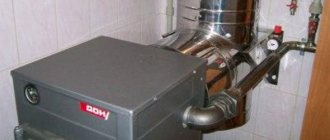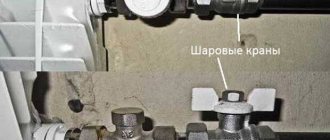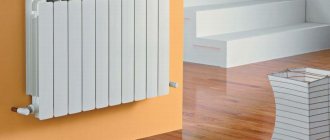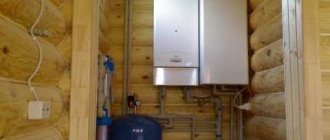Variety of designs
In vehicles with internal combustion engines, the following types of cooling are found:
- air;
- liquid based;
- combined.
The first type is considered obsolete. It was used on old Zaporozhets, the noise from which could be heard for many kilometers. The cylinder block was made ribbed (increased recoil area), and the air flow from the fan was directed onto it.
Liquid systems are used on all modern engines. Special solutions are used as circulating liquids, for example, antifreeze with a low freezing point.
In combined wiring systems it is supplemented by an installed fan. It starts automatically.
Liquid systems are open when circulation is provided with access to the external environment through the use of a steam pipe. The closed circuit does not imply communication with the environment, which allows the pressure inside to be kept above atmospheric pressure. The second type increases the boiling point by increasing pressure. As a result, the liquid can reach 110-120C.
There are three most popular options for moving coolant:
- Forced. The design uses a pump that forces antifreeze through the pipes.
- Thermosyphon. The movement of coolant is carried out due to the difference in the density of the antifreeze located inside the radiator and that available in the channels of the jacket. During operation, the warm mass from the engine goes to the upper area, moving into the radiator tank. Everything cools down there, its density coefficient increases, which allows it to move down to the incoming pipes of the engine jacket.
- Mixed (combined). For more overheated elements, for example, the cylinder head is forced to reduce the temperature using a pump, and the motor jacket operates in thermosiphon mode.
Which steel radiators are best to buy?
Steel radiators are divided into two types: panel and tubular. The former are cheaper and lighter, but less durable. The latter are more expensive and heavier, but withstand increased pressure and last longer. Models differ in design and operating principle. Let's look at these two types in more detail to understand which radiators are better for specific operating conditions.
Steel panel or tubular radiators
Panel steel radiators
The design consists of a panel filled with coolant and a corrugated metal sheet in contact with it for accelerated heat removal (the metal sheet increases the heat transfer area). The device works in two ways, combining them. The heat from the panel is transferred to the surrounding air, and its passage through the fins triggers natural convection in the room.
Sectional view of a steel panel heating radiator.
Panel radiator - type 11.
Panel radiator - type 22.
Panel radiator - type 33.
Advantages of steel panel radiators
- light weight;
- good heat dissipation;
- affordable price.
Disadvantages of steel panel-type radiators
- low resistance to hydraulic pressure shocks;
- low inertia (cools quickly after turning off the boiler);
- the appearance of dust in the air from convection.
Tubular steel radiators
This category is visually similar to cast iron batteries, but since the wall thickness here is 1.2-1.5 mm, they are much thinner and more aesthetically pleasing, unlike bulky radiators made of heavy metal. The design is based on a lower and upper collector connected by vertical steel pipes. There can be two, three or four of them in each section, which increases the volume of coolant and the area for heat exchange.
Steel tubular radiator.
Often the structure can be expanded by adding additional sections if the current number is not enough to heat a particular room. This cannot be done in panel types. This type of battery does not create strong convection.
Advantages of tubular steel radiators
- resistance to water hammer;
- long service life;
- more attractive appearance;
- shallower hull depth;
- Possibility of extension or shortening.
Disadvantages of tubular steel radiators
- higher cost;
- increased weight;
- may leak between sections.
Radiators with bottom or side connections
The lateral connection involves the supply of coolant to the upper fitting of the radiator, and the outlet of water through the lower one, located on the left or right of the body. This allows fluid to pass through all internal channels faster and is more efficient at heat transfer. But with this installation, more pipe will be required to supply it to the upper fitting, which can be located at a height of 300-850 mm. Such communications can also spoil the interior, and you will have to think about how to hide them behind false panels.
Panel radiator with side connection.
The bottom connection involves the supply and drainage of water through the fittings at the bottom of the radiator. When the panel is located close to the floor at a distance of 50 mm, such communications are not visible at all. This helps to make hidden wiring around the room without the cost of decorative materials. But the lower connection is less efficient in terms of the speed of mixing hot and cold coolant, so the heating efficiency decreases by 2-7%.
Panel radiator with bottom connection.
An example of calculating the required radiator power
In order not to make mistakes with heating efficiency, it is important to calculate in advance how powerful the radiator should be so that it is enough to heat a particular room. Here is the calculation formula:
Here is the calculation formula:
P=V*B*40+To+Td.
Let's look at the presented values:
- P is the radiator power, which we need to determine by substituting other values.
- V is the area of the room.
- B is the height of the ceilings in the room.
- 40 kW is the approximate heating power required to heat 1 m³.
- This is the inevitable heat loss on the windows, where one standard opening takes about 100 W.
- Td - similar losses occurring at the doors. Up to 150-200 W can be lost on one leaf.
Now we count. There is a bedroom with an area of 15 m², which has one standard window and one door. Which radiator should I buy for such a room?
15 m²*2.5 m (ceiling height)*40+100+200=1800 W. It is with this minimum power that you need to look for a radiator among panel or tubular options. If there is no exact value, then the choice is given in favor of the larger one.
Why is radiator certification so important?
When certifying radiators, the following is checked:
- compliance with the declared heat transfer power;
- thickness of steel walls (must be at least 1.2 mm);
- maintaining nominal and maximum pressure.
Radiator shape and design
Convective waste heat removal depends on boundary conditions including effective surface area, heatsink geometry, airflow velocity, and gravity orientation. The larger the surface area of the radiator, the stronger the convection. In order for passive radiators to operate at full capacity, it is important to maximize the convection surface area.
However, heat sink design is often limited by the size and shape of the lighting system. A passive radiator typically takes full advantage of the three-dimensional geometry to increase the convective heat transfer coefficient.
Typically finned to effectively increase surface area, allowing heat sinks to remain within a given area. The fins are located parallel to the direction of the air flow.
Modern LED radiator designs tend towards visually clean aesthetics and aerodynamic designs. Not only is the density and depth of the fins significantly reduced, but an increasing number of designs flow seamlessly between the ribs into the main metal structure, creating a smooth, minimalist look.
The aerodynamic design allows the low fin density radiator to capture as much airflow as possible. Some radiators that already have sufficient surface area eliminate fins entirely to resist dirt and dust buildup. Dirt and dust stuck in the radiator fins of common high bays and street lights are extremely difficult to clean. The accumulation of dirt and dust can significantly impair the convection and radiation efficiency of the radiator.
Operating principle: convection vs. radiation
The operating principle of a heating radiator is extremely simple. Water, which has already been heated to the required temperature, flows from the boiler into the room through pipes. Then it enters the heating devices, which heat the air in the rooms of your home.
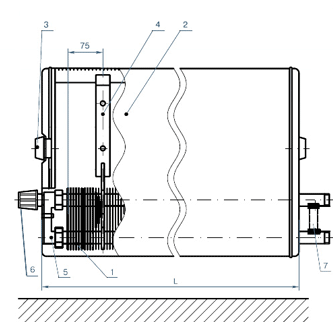
It is worth noting that if heat is transferred by convection - this is accelerated heating of air that flows through the heating surface, then such a heating device will be called a convector. If heat is transferred by radiation, that is, heating of the surrounding air is produced by a surface that has an increased temperature and heat capacity, then this will be a radiator.
Considering how a heating battery works, it is worth noting that in order to quickly warm up a room, a convector is more suitable. However, such a cross-sectional heating battery has one drawback - due to the passage of active convection, a lot of dust is released into the air, which will not have the best effect on the health of those present. That is why convector batteries are used only where there are problem areas of the heating system. For example, to create an air curtain in a room with a large glass area, where conventional devices cannot fit in size.
Regardless of the temperature in the heating radiators, they will give off approximately 60 percent of the heat by radiating thermal energy, while the rest will be given off by convection. Thus, a minimum of hot air convection is achieved and those objects located in the room are well heated. In this regard, it can be noted that the way a radiator works is similar to a heated floor system.

Connecting radiators
In any heating system, planning and design are important. This aspect will also include a diagram for connecting heating radiators. A drawing of a heating radiator can be in several versions. This can be an individual diagram or a diagram made based on the method of installing pipes in the field and the efficiency of the heat transfer rate.

Heat transfer power of a heating radiator depending on the type of connection
One-way connection is a common option. Thus, the designation of heating radiators in the drawings will show that all pipes are connected to the batteries on only one side. This scheme is the most convenient, especially in multi-story high-rise buildings.
Another option is that the marking of heating radiators shows that the connection is made diagonally, that is, crosswise. The peculiarity of this principle is that the pipe that supplies heat is connected to the radiator from the top on one side, and the outlet pipe is connected to the bottom on the opposite side. It is important here how the heating radiator is designed: such a scheme is suitable if the batteries are long and have many sections. The coolant will be distributed evenly over the entire area of the radiator, thereby ensuring excellent heat transfer.
There is also a bottom connection. Thus, the inlet and outlet pipes are connected to the lower pipes, which are located on opposite sides of the radiator. This kind of scheme will be inferior to the previous two. After all, it provides heat transfer efficiency of approximately 10-15 percent. However, such a scheme will be an ideal solution when the heating system is hidden in the floor.
Aluminum radiators
This type of heating device can also be used for heating. They look quite attractive in appearance, but this is not the best option for apartment buildings with a central highway. They are preferably installed in standalone conditions.
Aluminum batteries have the following advantages:
- Light weight. Compared to other materials, aluminum is the lightest among them. When compared with cast iron radiators, they are almost four times lighter.
- Good heat dissipation
- Simple and easy installation
- Possibility of assembling the required number of sections for batteries produced by the lithium method
- Reasonable price compared to others.
The disadvantages of this type of battery are as follows:
Demanding on the characteristics of the coolant. That is why it is undesirable to use it in centralized heating systems where low quality water is used. Low corrosion resistance and rapid wear. Service life on average 10-15 years

Low safety margin against water hammer, which is typical in apartment heating systems. Low operating pressure 10-15 atmospheres.
A special approach to choosing a fitting for this type of radiator. Fittings made of brass, steel or copper will cause corrosion if they come into contact with such radiators. Plastic pipes are more often used for aluminum batteries.
Radiator production methods
The manufacturing process is an indispensable aspect when choosing thermal conductive materials and radiator design. Different processes can create different part geometries, exhibit different thermal characteristics, and produce different mechanical properties. Nowadays, heat sinks can be manufactured using various metal forming methods such as casting, forging, extrusion, machining, stamping, sharpening and bonding.
Cast radiators
Manufactured by injecting molten aluminum into a metal matrix, which consists of two matrix halves joined and held together by hydraulic pressure. This process can produce aluminum heatsinks with the very complex shapes found in plastics, while still being able to operate effectively in environments with high ambient temperatures. Injection castings are characterized by high dimensional accuracy and stability even with thin walls. Smooth or textured surfaces can be easily created and require minimal surface preparation before electroplating, coating or finishing. Injection molding is the most efficient and economical process for mass production of LED heat sinks. It allows the production of radiators with fins and fins of complex geometric shapes without compromising thermal integrity.
Cold forging
It is a metal forming process in which a metallic material is plastically deformed below its recrystallization temperature (usually at room temperature) under intense pressure. Cold forgings are superior to many other processes in thermal conductivity, mechanical strength, dimensional accuracy, surface quality, production cost and productivity. The process ensures favorable crystal grain flow and thus results in improved thermal performance. Cold forged radiators typically provide up to 15% improvement in thermal performance over extruded radiators and up to 80% compared to injection molded radiators. With minimal resistance to deformation and high ductility, aluminum and its alloys are well suited for this process. The cold forged heatsink using aluminum alloys in the 1000 range has a thermal conductivity of 220 W/mK to 240 W/mK.
Extrusion
This is another common heat sink manufacturing process in which aluminum flows plastically under compressive forces into various shapes. Complex 2D profiles can be extruded through a die bore and then cut into various lengths. This process does not create internal porosity, which can affect thermal conductivity, and therefore produces aluminum radiators with higher thermal conductivity than die castings. Aluminum alloy profiles have thermal conductivity in the range of 200-215 W/mK. Aluminum extrusions are primarily used to create linear lighting systems for cove lighting, under cabinet lighting and other architectural lighting installations that use LED strips as the light source. This process can also produce low profile radiators with very complex cross sections.
Stamping
It is a cold forming operation for making sheet metal parts. Metal stamping is accomplished by inserting flat metal sheets into a die and using various metal processing techniques to shape the metal into the desired geometry. Metalworking techniques most commonly associated with stamping include stamping, punching, deep drawing, pressing, embossing, bending, and flanging. This process is primarily used to make ribs for pegs and inserts. Stamping can easily expand the scalability of heat sink solutions from a few watts to several hundred watts. This cost-effective process allows for large-scale, full-size production runs.
Radiators with connected fins
Designed to provide maximum fin density and depth to allow for high volume of convective heat transfer. The radiator is designed in such a way that an array of high-density plate fins is assembled into a grooved base. The bonding agent, which can be a thermosetting heat-conducting epoxy resin or solder, holds the plate fins tightly in place. Despite the use of a thermally enhanced binder, there is still interface resistance between the fins and the base. Linked radiators are available in a wide range of materials and manufacturing options. This solution allows the use of hybrid radiators that combine different materials and metalworking processes of the fins and base. The grooved base can be extruded, injection molded or machined. Lamellar fins can be extruded or stamped.
Radiators with finned fins
Carved from metal blocks. Unlike bonded fin heat sinks, in which the plate is mounted into slots on an extruded or machined base and the fins are held in place by an adhesive, beveled fin heat sinks have no interface resistance because they are made from a single piece of aluminum or copper. The stripping process produces a high aspect ratio (higher ribs and higher density). These thermal characteristics allow finned radiators to provide effective thermal management. However, the stripping process is not a cost-effective solution for mass production of LED heat sinks.
Machined Radiators
Similar to the factory stripped ones, except that these radiators are cut from a block of metal using a multi-saw cutting process. Both machining and gearing waste raw materials unproductively, so they are less often used as radiators for LEDs. The only advantage of treated radiators is the short production time of small batches and high thermal conductivity as a result of the low thermal resistance of the entire structure.
Installation of bimetallic radiators
special key
Even before installation begins, you should decide on the wiring diagram and connection method. The wiring can be serial or parallel. In a private house, two-pipe parallel wiring is more often chosen; in a city apartment, only single-pipe serial wiring is possible. The radiators themselves are most often connected diagonally.
The entire tool can usually be purchased together with heating appliances. However, there are situations when special fasteners are necessary due to the design of the walls (too thin or too hard). Installation recommendations are contained in the instructions.
First, the fastenings are marked, then a Mayevsky crane is mounted on each device. It should be taken into account that the distance from the floor to the device should be 8-10 cm, from the window sill to the device - 5-10 cm, from the wall to the radiator - 2-5 cm. The protective film from the radiators is removed only after they are connected to the heating system.
Immediately after installation, connections are made and air is released from the devices. Experts believe that approximately a bucket of water should be drained from each battery. If no leaks are detected at startup, they will not appear later. If leaks do exist, they should be repaired immediately.
Aluminum radiators
Aluminum radiators today are considered the most efficient due to the high thermal conductivity of aluminum and the increased surface area of the radiator due to the protrusions and ribs. Almost all modern radiators designed for operation in central heating systems have an operating pressure of more than 12 atm, and a pressure test pressure of more than 18 atm.
The advantages of aluminum radiators include lightness, small size, high operating pressure, maximum level of heat transfer [ source not specified 3055 days
], large cross-sectional area of the intercollector tubes.
A significant disadvantage of aluminum radiators is the corrosion of aluminum in an aqueous environment, which is especially accelerated by the contact of two dissimilar metals or the presence of stray currents in the heating network [ source not specified 3055 days
].
Aluminum is an active metal, and if the oxide film covering its surface is damaged, then upon contact with water the latter decomposes with the release of hydrogen. If the heating device is hermetically sealed, the increasing gas pressure can cause the radiator to rupture. This phenomenon is combated by applying a polymer coating to surfaces in contact with water, which also improves anti-corrosion properties, allowing the use of coolants with a pH level from 5 to 10; reduces hydrodynamic resistance, prevents blockages and sticking. If the radiator does not have an internal polymer coating, turning off the taps on the supply pipes is prohibited [ source not specified 3055 days
].
Aluminum radiators are most often divided into three main types: cast with solid sections, extruded with a mechanically connected set of sections, and combined, combining the qualities of both of these types. For work in high conditions [ what?
] operating pressure, bimetallic radiators made of aluminum and steel are used.
Solid aluminum radiators
These radiators are structurally composed of profiles made by extrusion and connected to each other by welding. The aluminum used in them does not require any additives and therefore retains its ductility; Accordingly, external shock impacts and internal water hammer do not cause chipping of the ribs and cracking of such radiators. The absence of intersectional gaskets in such radiators gives them strength and reliability, and with an internal polymer coating, their durability can exceed the durability of cast iron radiators [ source not specified 3055 days
]. However, since their design is non-demountable, they cannot be expanded during operation.
Sectional aluminum radiators
Such radiators structurally consist of sections made by injection molding, which are connected to each other using threaded connecting elements (nipples); the intersection joint is sealed using gaskets made of paronite, high-temperature silicone or other materials. Sectionalization provides the opportunity to expand the radiator during operation or replace a damaged section, however, the presence of intersectional connections has a negative impact on reliability; In addition, the inner surface of the sections is characterized by greater roughness.
Thermal conductivity of the radiator
Heat is typically transferred in three ways: convection, conduction, and radiation. This conductivity refers to the type of heat transfer that occurs in a solid. Since a heatsink is also a solid device, heat transfer occurs through conduction in the heatsink.
Thermal conduction is the transfer of heat through microscopic particle collisions and the movement of electrons between objects with different kinetic energies. In addition to the ambient temperature, the removal of waste heat by conduction depends on the thermal conductivity of the material from which the heat sink is made and the geometry of the heat sink. Metals, metal alloys, some metal oxides, ceramics, diamond and other forms of carbon are good conductors of heat. Graphene, an allotrope of carbon in the form of an atomic-scale two-dimensional hexagonal lattice, has an astonishingly high thermal conductivity of 5000 W/mK. Among metals, pure copper has the highest thermal conductivity (about 400 W/mK). Aluminum and its alloys have moderate thermal conductivity in the range of 90-240 W/mK. Ceramics, which are both electrically insulating and thermally conductive, provide thermal conductivity of 100 to 200 W/mK. In LED lighting systems, conduction is the first way heat is transferred along the thermal path. It starts at the semiconductor junction and the thermal load passes through a series of components, ending at the convection surface of the heat sink.
How does conduction occur?
Imagine that you bring two different objects with two different temperatures closer to each other. A warm object will have fast moving molecules, while a cold object will have slow moving molecules. When these two objects meet at a point, the fast moving molecules will try to interact with the slow ones. This transfers energy from fast moving molecules to slow moving molecules. This process heats up the cooler object. This entire process is thermal conduction. This is the main operating principle of the radiator.
A little history
The history of the creation of radiators goes far back, several thousand years ago, when people began to think about how to make their home warm and comfortable for living in the cold season. Then they heated themselves using an open fire, the smoke from which escaped through a special hole. The first heating battery appeared already in Ancient Rome in the form of a stove with a pipe. Interestingly, some modern houses still use this type of heating system to this day.
In 1855, German entrepreneur Franz San-Gali created the first cast iron radiator and called this device a “hot box”. The cast iron radiator has become widespread throughout the world and was used in steam heating systems. This was a serious start for new inventions in the field of heating. The first tubular steel radiator, invented by Rubert Zehnder, appeared in 1930. This discovery was a triumph. The battery was named Zehnder and demonstrated excellent technical characteristics: lighter weight than cast iron units and high heat transfer.
A little later, bimetallic radiators appear that combine both steel and aluminum, embodying all the advantages of steel and aluminum batteries. Subsequently, many companies mastered this technology, and it is still successfully used in the modern world for the production of radiators. Cast iron batteries came to Russia in the 20s, and already in the 40s all Soviet apartments had cast iron heaters. Aluminum and bimetallic radiators in Russia became popular much later than in Europe.
Steel radiators
Steel panel radiators
Steel panel radiator with thermostat
Such a radiator is a rectangular panel consisting of two steel sheets welded together with stamped recesses, which, when welded, form channels for coolant circulation. Sometimes, to increase heat transfer, U-shaped steel ribs are welded to the back of the panel. Several of these panels can be combined into a package and closed on the top and sides with decorative strips.
Panels are available in various heights and widths, which allows you to create a device of any thermal power. Panel radiators have a small depth and weigh little; Accordingly, their thermal inertia is insignificant. The heated surface area of the panels is very large and stimulates intense movement of heated air - the proportion of heat flow transmitted by convection reaches 75% [ source not specified 2376 days
], which allows us to classify these devices as convectors.
For the manufacture of panels, low-carbon steel with increased corrosion resistance is used. The steel surface is degreased, phosphated, coated with powder enamel and heat treated.
In cases where the heating system is directly exposed to the atmosphere (for example, through an open expansion tank), these radiators are prone to corrosion and their service life may be only a few years.
The disadvantages of panel steel radiators include the low operating pressure for which they are designed, sensitivity to water hammer, and lack of protection of the inner surface from the corrosive effects of water. These properties limit their scope of application to autonomous heating systems with good water treatment. In addition, the back surfaces of the devices are difficult to access to remove dust.
In most cases, panel radiators are designed for operating pressure from 6 to 8.7 atm, pressure testing - up to 13 atm and a maximum coolant temperature of 110 °C [ source not specified 2376 days
]. They are recommended for use in individual and low-rise construction, and in the presence of an individual heating point - in buildings of any number of floors.
Steel sectional radiators
Externally, these radiators resemble cast iron ones, but their sections are connected to each other not with threaded nipples, but with the help of spot welding. They are stronger and more durable and are designed for operating pressures from 10 to 16 atm [ source not specified 2376 days
]. However, due to the peculiarities of production technology, the cost of these radiators is quite high, which determines their relatively low popularity.
Steel tubular radiators
Tubular steel radiators are a welded tubular structure and are the most expensive. They are produced for a working pressure of 10-15 atm [ source not specified 2376 days
]. Welded joints minimize the likelihood of leaks, but the disadvantage of these radiators is the small thickness of the steel (1 mm or less).
Bimetallic radiators
Bimetallic radiator
Bimetallic radiators differ from aluminum radiators in the presence of steel internal elements. The design of these radiators is such that the safety margin exceeds all possible pressures in the system many times over (the destructive pressure is 100 atm), and the contact of the coolant with aluminum is reduced to almost zero. The only drawback can be considered only the highest cost among radiators.
Applicability of automobile radiators
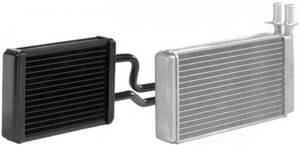
Interior heater radiators

Automatic transmission oil cooler
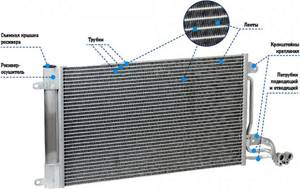
for various purposes can be installed on cars:
These radiators may have significant differences in design. For example, heater radiators are small in size, and air conditioner radiators have several pipes for supplying refrigerant. Oil radiators are usually made in the form of a single pipe, rolled into a spiral or bent into an accordion, around which there is a package of plates or tapes (or without plates at all). And the intercooler radiator has a large cross-section of pipes and pipes, which allows the passage of a large amount of air without significantly increasing the flow resistance.
Types of steel radiators, based on their design features
Steel radiators can be of two types:
- Tubular radiators;
- Panel radiators.
Panel radiators are manufactured according to the following scheme: the panel of such devices is welded from two plates, and coolant circulates between these plates. Typically the plates have a thickness of 1.2 to 1.5 mm. Spot welding is used to connect these plates.
Which steel heating radiators are better: installation and assembly Steel panel radiators
Among the advantages of panel steel radiators is the ability to choose a device with the most suitable dimensions for you.
Panel radiators, in turn, may differ in the method of connection to the heating system. There are three ways to connect steel panel heating devices:
- Lateral connection;
- Bottom connection;
- Universal connection.
Options for connecting heating devices
In the case of a bottom connection, the heater must be equipped with a built-in thermostatic valve. It will be possible to mount a thermostat on this valve. Thanks to a device such as a thermostat, you can maintain the temperature that is most comfortable for you.
Metal heating radiators with a side connection type are considered cheaper. In this case, you can also use the natural circulation of coolant in the heating system. In addition, this connection is not as noticeable as the bottom one.
Radiators made from several panels have higher heat transfer. This design allows heat to be transferred only to external-type planes, so U-shaped plates can be welded to their internal surfaces of the device. Thanks to this, you can increase the surface that will give off heat.
Three-panel steel radiators
However, three-panel radiators also have some disadvantages. First of all, this concerns their weight. In terms of weight category, such devices can catch up with cast iron batteries, which are quite heavy. In addition, such a device will require a larger volume of water, so the effectiveness of thermal control will be significantly reduced. In terms of thickness, such radiators surpass even cast iron appliances, since they can be up to 160 mm thick. Another disadvantage is the fact that the inner area of the panel radiator is a little more difficult to clean from dirt.
Panel heating radiators
Tubular radiators are most suitable for administrative buildings or houses with one or more floors. Tubular radiators can withstand operating pressure of no more than 8-10 atmospheres. The thickness of their walls varies from 1.3 to 1.5 mm. Such devices can reach a height of 300 cm. Tubular steel radiators, in turn, can be of types such as sectional or non-sectional.
Tubular steel heating radiators
Selection rules
Heating radiator appliances are by no means cheap, and are purchased for more than one heating season. Therefore, the choice of heating model should be approached with all responsibility. The first step is to calculate the required heat transfer for your apartment. We'll look at how to do this below. Next, you will need to select the directly appropriate type of heating device:
- Check out all the price segments presented in the store. Immediately discard the most expensive and cheapest options. The most inexpensive heating devices may turn out to be of low quality, but you shouldn’t overpay just for a brand name.
- Select the appropriate modification based on the material of manufacture. The durability of use depends on this, but the properties of the metal also affect the price.
- For multi-apartment buildings with centralized heat supply, it is better to select models with a nominal design pressure of at least 12 atmospheres. For private houses with an autonomous boiler, this indicator is not so relevant due to low pressure in the intra-house network.
- The optimal place to install a heating battery is under the windows. This creates a thermal curtain for the flow of cooled air into the room. Therefore, before purchasing, you should measure the height of the window sills so that the purchased radiator can fit under the window.
When choosing a suitable radiator device, first of all, pay attention to the quality of the product, and only then to its aesthetic properties. Please read the technical instructions carefully before determining whether this model is suitable for you.
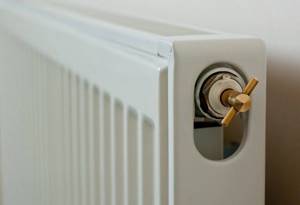
Mayevsky tap on an aluminum radiator
When purchasing heating equipment, you must immediately purchase all the necessary components: fastening devices, Mayevsky valves for bleeding air, damper safety valves. A complete list of additional parts required for each specific modification can be obtained from your sales consultant.
Current system
Domestic and foreign cooling systems are overwhelmingly closed, where liquids are forced to move. Their main elements are:
- cooling radiator;
- pipes and connecting hoses;
- jacket (technological channels of the block);
- water pump;
- multi-blade fan;
- thermostat.
When the power plant is operating, the antifreeze located in the channels of the jacket receives heat from the engine. Then it moves through the existing channels to the radiator to cool, and returns back through other channels. The movement is aided by a pump located in the system, and cooling is facilitated by a large fan located behind the radiator. The work intensity is adjusted by a built-in thermostat and timely auto-start/auto-stop of the fan.

Topping up the required volume of antifreeze is carried out through a special neck in the radiator. This can also be done using an expansion tank. As a rule, modern systems fit about 6-12 liters of antifreeze. It can be replaced after it has been completely drained by unscrewing the cap on the block or at the bottom of the radiator tank.
Cooling radiator
The main element of the engine cooling system is the radiator installed in the front part of the engine compartment. It takes on air flows, thereby cooling the working fluid.
The coolant is most often antifreeze, which circulates through a network of pipes and channels inside the engine. A special pump pump pumps the liquid, creating acceptable pressure and preventing stagnation of the liquid.
If there is no airflow to the radiator and the engine temperature rises above normal (for example, when the car is stuck in a traffic jam), the fan turns on. Meanwhile, after 5-7 years of operation, the front radiator becomes clogged with dirt, insect remains, particles of leaves, chemical dust and other debris. Therefore, its airflow is disrupted and proper cooling of the antifreeze does not occur.
As a result, the main radiator must be removed and washed separately. Moreover, you cannot use a Karcher, since the jet from the sprayer can crush the radiator cells.
Steam from the engine. What to do if the radiator leaks on the road? More details



